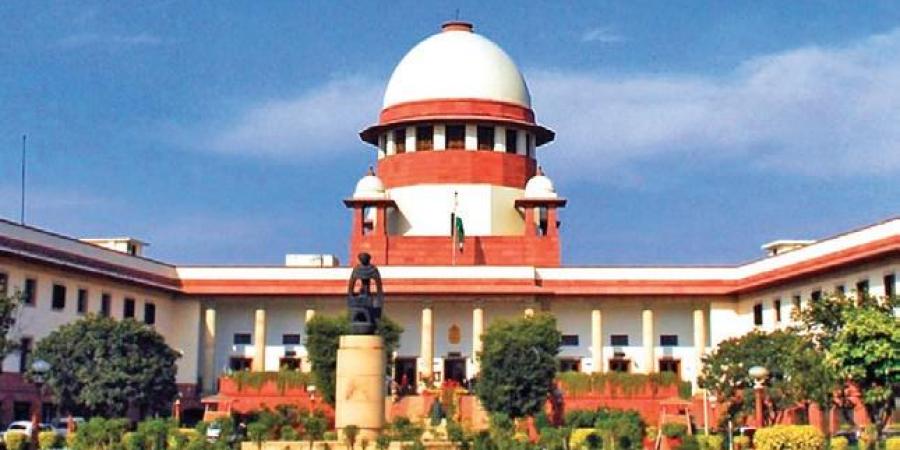Coffee, the world's most popular beverage, is enjoyed for its rich flavour and invigorating energy boost. But beyond the satisfying cup lies a journey from bean to brew. As a discerning coffee drinker, understanding how to select the right beans at the market,...

Home Buyers Interests Put Above All
Home Buyers Interests Put Above All
Apex Court held the Insolvency and Bankruptcy Code (IBC), 2016 – The object and purpose of the IBC is not to kill the company and stop/stall the project, but to ensure that the business of the company runs as a going concern.
Dr Prem Lata
What is Article 142 of the Constitution of India?
The Indian Judiciary and the Constitution of India believe that every citizen of India must get “complete justice”. The Constitution of India under Article 142 grants the power to the Supreme Court for passing any decree to do “complete justice” Further, there is no specific guideline or rule provided by the law which explains when, where and under which circumstances the Apex Court can invoke the said article to do “complete justice”.
This was yet another way by which homebuyer’s interest is protected by making an arrangement to settle their disputes in a very short procedure before National Company Law Tribunal (NCLT). For years, home buyers were dependant on Consumer Commissions only for the redressal of their grievance and refund of their hard earned money invested with builders. Then came the RERA (Real Estate Regulation and Development) Act 2016, which came as an additional remedy to home buyers and made a remarkable change in the real estate sector. The amendment in section 5 of IBC 2016 made home buyers financial creditors which was another boost for consumers. With this, yet another window opened for investors in developers’ projects and now NCLT also came ahead in settling accounts between disputing parties.
The courts are creating history by adopting very positive approach towards the aggrieved consumers through number of judgments during the last decade which is a big relief to the general public at large. In the above case, the Hon’ble Supreme court has exercised its power under Art 142 of the constitution (which is done in rare cases) and given relief to both the parties, home buyers as well as the developers and brought an end to the litigation.
Details of the Case
Home buyers in the housing project, Krrish Provence Estate at Gurgaon had gone against Jasmine Buildmart Pvt and invoked Section 7 of IBC 2016 before the Adjudicating Authority/NCLT, Delhi in CP No. 1722/ND/2018 seeking initiation of CIRP against Builder, the Corporate Debtor and obtained order in their favour. NCLT/Adjudicating Authority admitted Section 7 application on 28.11.2019 and appointed the Interim Resolution Professional ‘IRP’ and declared a moratorium. The original applicants had sought refund of an amount of Rs.6, 93, 02,755/- due to an inordinate delay in the completion of the project and failure to handover possession within the stipulated time and could not complete the project even after a period of eight years. Builders knocked at Supreme Court’s door for stay on the insolvency proceeding against them as ordered by NCLT, in view of the fact that parties have settled the matter between themselves and the petitioner/home buyers be allowed to withdraw their application under section 7 of IBC 2016.
How was the Matter Resolved?
It was revealed before the Court that out of 128 home buyers of 176 units, 82 home buyers have settled the dispute with the corporate debtor including the original applicants/respondent nos. 1 to 3 who had initiated the IBC proceedings. It was reported that the original applicants/ respondent Nos.1 to 3 as well as 79 home buyers have settled the dispute with the corporate debtor in terms that the corporate debtor shall complete the entire project and hand over the possession to the home buyers who wanted possession within a period of one year from today. In view of this development and pursuant to order dated 4.2.2022, 1 to 3 original applicants before the NCLT who has initiated the proceedings under Section 7, filed an application for withdrawal of the proceedings. However, there is no provision in the Code or the CIRP Rules in relation to permissibility of withdrawal post admission of a CIRP application. In the present case, although the COC was constituted on 23.11.2020, there has been a stay of CIRP proceedings on 3.12.2020 (within ten days) and no proceedings have taken place before the COC. It is to be noted that the COC comprises 91 members, of which 70% are the members of the Flat Buyers Association who are willing for the CIRP proceedings being set aside, subject to the appellant and the Corporate Debtor – company honouring its undertaking given to this Court as per the settlement plan dated 3.2.2022. Therefore, in the peculiar facts and circumstances of the case, where out of 128 home buyers, 82 home buyers will get the possession within a period of one year, as undertaken by the appellant and respondent No.4 – Corporate Debtor, coupled with the fact that original applicants have also settled the dispute with the appellant, we are of the opinion that this is a fit case to exercise the powers under Article 142 of the Constitution of India read with Rule 11 of the NCLT rules, 2016 and to permit the original applicants to withdraw the CIRP proceedings.
The Jasmine Buildmart Pvt. Ltd. were directed to file separate undertakings before this Court, within a period of one week, specifically stating and undertaking that:
- They shall complete the entire project within one year from 01.03.2022 and offer the possession to the respective home buyers.
- They shall complete the entire project including all the apartments, common areas, amenities, etc.
- All demands be raised and timely paid.
- Company shall continue the provisions of all maintenance services.
- Company will make the application for obtaining Occupancy Certificate within six months, before the competent authority.
All Editorials
From Bean to Bliss: How to Find Your Ideal Coffee Match
Beat the Heat: Consumer Safety During Summer Heatwaves
Heatwaves are a common feature during the summer months in India, with temperatures in the range of 45-47°C (113-117°F). Northwestern India is subject to the most intense heat, and heatwaves are possible in any part of the country. The extreme temperatures and...
Unmasking Air Pollution’s Impact on Pulmonary Health
Over the past few decades, air pollution and climate change have become major global concerns. Air pollution has many detrimental effects that pose a threat to global public health in terms of significant disease burden as well as mortality. It is disturbing that...
Cracking Cheese Codes: Healthy Choices, Labels, and Storage Tips
Cheese is a creamy, tangy, versatile delight that can elevate any dish and melt our hearts and taste buds in seconds. However, it is often thought to have negative effects on our health. With a little mindfulness, you can make healthier choices when it comes to this...
Navigating Consumer Challenges in India: Implementing Effective Measures
In the diverse and vibrant landscape of India, consumer-related issues have emerged as a critical facet of daily life. As the nation progresses economically and the consumer market expands, individuals face a range of challenges that demand attention and proactive...
Navigating AI Influence: Consumer Caution Ahead
In the modern digital landscape, artificial intelligence (AI) is a powerful force influencing consumer decisions. AI algorithms leverage vast data to grasp consumer behaviour and preferences, fuelling personalized recommendations and targeted advertising. In the realm...
Navigating the Web: A Consumer’s defence Against Dark Patterns
Consumers are finding themselves in a wide online landscape in an era of digital convenience. Although there are many advantages of the internet, it is important to stay vigilant against such practices commonly referred to as dark patterns. These subtle design choices...
Portion Smart: Eating Foods, the Right Way
Imagine a bag of chips. The label might list a serving size as 28 grams, but let's be honest, who stops at just that? That's where portion size comes in. It's the amount of food you choose to eat, which can be more or less than a serving size. Think of a serving size...
A continuous surge in antimicrobial resistance
Antimicrobial resistance (AMR) is the 21st-century global public health problem. AMR occurs when microbes, such as bacteria, viruses, fungi and parasites stop responding to antimicrobial medicines. Because of the high rate of antibiotic overuse that leads to...
NutriBars Decoded: Making Informed Choices
As I navigated the bustling supermarket aisles, my attention was drawn to the vibrant array of NutriBars lining the shelves. Each bar boasted enticing claims, from "high protein" to "low sugar”, but the sheer variety and conflicting messages left me feeling...
Empowering Consumers: Navigating the Digital Age and Celebrating Consumer Rights on National Consumer Day
National Consumer Day is observed annually on December 24th in India, marking the enactment of the Consumer Protection Act, 1986. It emphasizes awareness of consumer rights, responsibilities, and the significance of protection. The Act was a pivotal step in...
Food Contact Materials and Your Health: Tips for a Safer Approach
Recently, the Food Safety and Standards Authority of India (FSSAI) issued a strong advisory urging both consumers and food vendors to refrain from using newspapers in any capacity related to packing, serving, or storing food items. The FSSAI emphasized the potential...
Unlocking Minds: Understanding the core of Alzheimer’s disease and dementia
Alzheimer's disease, a progressive neurodegenerative disorder, primarily affects memory and cognitive function. It is the most common cause of dementia, gradually impairing daily life. Research aims to understand its complex pathology and develop effective treatments...
World Diabetes Day 14 th Nov, 2023 – Access to Diabetes Care
Authors: - Dr. Pankaj Bhardwaj (Dr Pankaj Bhardwaj, Academic Head, School of Public Health (SPH), Professor of Community Medicine & Family Medicine All India Institute of Medical Sciences (AIIMS), Jodhpur and Dr. Madhukar Mittal (Additional Professor and Head,...
Revitalizing Millet Consumption: Shifting Focus from ‘Big Food’ to Government Schemes and Local Outlets
Shifting away from dependence on the 'Big Food' industry to boost millet production and consumption, policies should emphasize integrating millets into government food schemes. Highlighting the limitations of Production Linked Incentives in realizing millets'...
The Emerging Crisis of Antibiotic Resistance
One of the greatest medical discoveries of the 20th century, antibiotics have saved countless lives by efficiently treating bacterial infections around the globe. However, the overuse and abuse of antibiotics have given rise to a formidable adversary, antibiotic...
The Significance of IRR in Investment
Shri Sharad Ranjan and Shri Hariti Tyagi The BackstoryThe relationship manager of a well-established bank reached out to my daughter, who is in the beginning of her twenties, and proposed an investment plan. The investment plan, according to him, is the best...
Sabudana Unveiled: The Tapioca Tale and Beyond
Sabudana holds a special place in the hearts and traditions of millions. These small, translucent globules have become synonymous with fasting seasons in India, particularly during religious festivals like Navratri, Shivaratri, Ekadashi, and Saawan season. During...
Recurrent pregnancy loss
With an increasing number of affected couples, recurrent pregnancy loss (RPL) has become a widespread reproductive health problem. Clinically, it is defined as the loss of three or more pregnancies before the foetus reaches viability. It affects approximately 3...
From Grain to Gain: Mastering the Art of Aata Selection
Are you aware of what goes into that essential ingredient that forms the foundation of countless Indian meals? Yes, we're talking about aata, the versatile flour that brings us the beloved rotis, chapatis, and parathas. But have you ever stopped to consider the...
Are freebies good for economic health and can they empower the poor?
Does India need freebies from the government to survive? What is now popularly called the ‘freebie politics’ has its own economic implications. As the proverb goes there are no free lunches, freebies in the form of free units of power can be detrimental for the...
DNA Fingerprinting: A key to know your ancestry
A new field of study was opened in 1984 when Professor Sir Alec Jeffreys generated the first genetic fingerprint in his lab at the University of Leicester. Talking about his discovery, Sir Alec said, "My life changed on Monday morning at 9.05 am, 10 September 1984....
Decoding the Secrets of Buying the Best Saffron
Did you know that saffron is one of the most expensive spices of the world? It is used in a variety of dishes in India. Its application extends to traditional medicine and cosmetics as well. Also, saffron is an important part of many religious ceremonies in India,...
Rise and decline of the Consumer Movement in India
The consumer movement is an organised social movement that promotes consumer protection and is often led by consumer organisations. It argues for consumer rights, particularly when those rights are actively violated by the activities of corporations, governments, and...
वॉयस की 40वीं सालगिरह
उपभोक्ता शिक्षा और जागरूकता में 40 वर्षों से काम कर रही है कंस्यूमर वॉयस कंस्यूमर वॉयस लगातार 40 वर्षों से उपभोक्ता शिक्षा और जागरूकता के क्षेत्र में संघर्षरत एक स्वयंसेवी संस्था है। वॉयस लगातार भारत में उपभोक्ताओं के लिए उनके उपभोक्ता अधिकारों के संघर्ष कर रही है।...
40 years of VOICE – The Beginning
There is no particular date on which we launched VOICE in April 1983 at the Delhi School of Economics campus at Delhi University. There was no launch ceremony or event. It was born out of the drafting of a complaint by VOICE signed by me and about 30 of my students....
Buttermilk: A Refreshing Summer Drink
Buttermilk is an excellent summer beverage that is not only refreshing and delicious, but also good for your health. Buttermilk has numerous benefits, including being low in calories and fat, high in protein and calcium, and containing probiotics which can help...
Women’s Health and Nutritional Needs
Every year we observe March 8 as International Women’s Day. According to the Unite Nations, the purpose of this day is to uphold women's achievements, recognize challenges, and focus greater attention on women's rights and gender equality. The state of women's health...
Makhana: A Superfood for Sure!
Makhana, also known as Foxnut, is a widely consumed snack during fasting in India. It is becoming a popular snack among health-conscious consumers due to its healthier nutrient. Makhana is mixed with different seasoning and flavouring substances, and a range of ready...
Maltodextrin: What is it?
If you go through food labels, you must have come across maltodextrin in the ingredient list. It is a commonly used ingredient in processed packaged foods. Maltodextrin has several applications in the food industry, has some health benefits but it has also been...
Gut Microbiota and Nutrition
Human gut is home to many species of microbes, collectively referred as ‘gut microbiota’. They can be both symbiotic and pathogenic in nature, coexisting together without causing any trouble. Sometimes this balance could be disturbed due to infectious illnesses,...
Choosing Quality Eggs
Eggs are one of nature's most nutrient-dense foods. They are rich in essential micronutrients and provide high-quality protein. There are innumerable benefits of eating eggs regularly. Selection of eggs is simple, but presence of different varieties of eggs in the...
Healthy Workplace, Healthy You: Preparing workforce for a safe, healthy and sustainable food system through the Eat Right Campus
Apart from your own home, which place do you eat most frequently on a daily basis? If you think about it, it is likely to be your office, college or an institution that you visit regularly. In today’s fast-paced environment, a large number of working professionals and...
Eat Right Challenge
Food Safety and Standards Authority of India (FSSAI), has initiated the Eat Right India movement. The movement is based on three key themes, ‘if it’s not safe, it’s not food’ (safe food), ‘food should not only serve the palate but is also meant for body and mind’...
Chocolates: Are they Good or Bad for Health?
Chocolates are either critiqued to have negative impact on health or are portrayed by the marketers to have health benefits especially dark chocolates. The truth is that the composition of every chocolate is different from the other one, and this along with the amount...
Diet Soda: Are they good for your health?
Diet sodas are a popular beverage all over the world, among people of all ages who are anxious to reduce their sugar or calorie intake. Instead of sugar, artificial sweeteners, such as aspartame, cyclamates, saccharin, acesulfame-k, or sucralose, are used to sweeten...
State Food Safety Index 2021-22
To encourage States/UTs to improve their performance and work towards establishing a proper food safety ecosystem in their jurisdiction, the Food Safety and Standards Authority of India (FSSAI) has released the State Food Safety Index (SFSI) annually for each...
Choosing the Right Cookware and Tableware for Your Home
We take utmost precautions while handling food to prevent contamination or any food hazard. However, have you given a thought about the utensils in which it is cooked, served, or stored? In this article, we will discuss cookware and tableware made from different...
Eat Right India: Steadily Reforming India’s Food Ecosystem
Safe foods and healthy diets are critical in the context of India's rising burden of food borne diseases, under-nutrition, micro-nutrient deficiencies and non-communicable diseases (NCDs) like hypertension, diabetes, heart related diseases, etc. According to the...
EatSmart Cities Challenge
The Food Safety and Standards Authority of India (FSSAI) in association with the Smart Cities Mission under the aegis of Ministry of Housing and Urban Affairs (MoHUA) recently announced the winners of the EatSmart Cities Challenge. The 11 winning cities include...
Stay Healthy This Summer!
Summers are here, and accordingly we must make some dietary changes in this season to adapt to the heat. Summer calls for a diet which helps us to cool down our body temperatures. As temperature rise, we tend to sweat more in summers therefore keeping ourselves...
Reducing Anaemia through Large Scale Food Fortification
Micronutrients are essential to sustain life and for optimal physiological functions. High prevalence of micronutrient deficiency is affecting the lives of more than 2 billion people in the world despite substantial efforts to decrease its prevalence for the past few...
Home Buyers Interests Put Above All
In civil appeal No. 3778 of 2020 in the Supreme Court, the bench of Judges M.R. Shah and B.V. Nagarathna, in case of Amit Katyal V/S Meera Ahuja & others, allowed the withdrawal of Corporate Insolvency Resolution Process (CIRP) against a builder in an application...
Is Inter-meal Munching a Healthy Habit?
Munching between meals is often seen as an unhealthy habit. Mostly because the snacks we usually munch on are unhealthy and could be high in calories, fat, sugar, and salt, and low in essential micronutrients. But it is wrong to think that inter-meal munching is a bad...
Testing: Critical for Ensuring Food Safety
Food safety is one of the major determinants of a sound and cohesive healthcare system in a country. As food chains are becoming longer, complex and globalized, contamination of food leading to food borne diseases is a growing concern. Unsafe food not only poses a...
Is Vegan Meat Healthy For You?
Will eating more plant-based or vegan meat benefit both our health and the environment? This question has been a debatable and an ongoing one. People believe that plant-based meat could be a sustainable answer to global environmental concerns. However, many...
World Consumer Rights Day: Do Consumer Courts treat consumers as kings?
Since 1983, March 15th has been celebrated as World Consumer Rights Day. It is the day when the US President, John F Kennedy sent the message to the US Congress in 1962 outlining the four fundamental consumer rights - the right to safety, the right to be informed, the...
Food Systems Approach: Towards achieving safe, nourishing and sustainable diets
Food is an integral part of our life and thus there has always been an exclusive focus on what we eat. Unless the food we eat is safe, we become vulnerable to food-borne illnesses, which in turn reduces our ability to absorb nutrients, fight infections thereby,...
Devising a healthy trans-fat free life
The growing incidence of non-communicable diseases is a wakeup call for us to ensure we create a safer food system and understand why trans fats is a critical challenge for our country, writes Shri Arun Singhal, CEO, FSSAI. As the world is advancing and systems are...
A2 Milk: Why you should know more about it?
You might have heard about A2 milk and the claims that it is better than the regular milk (A1 milk) commonly available in the market. Consumer perceives such milk as better option than regular milk. Even A2 ghee too is perceived as healthier. But, what’s the reality?...
Are health drink powders actually good for you?
Intro: India is one of the largest consumer markets for malt-based drinks in the world. Malt-based products are marketed as ‘health drinks’ and are specifically targeted at children, and their parents. They are often marketed as an essential product that provides...
Maximise health by minimising salt, sugar and fat
It is increasingly becoming apparent that high consumption of salt, sugar and fat is one of the prime reasons behind the risk of developing lifestyle diseases like diabetes, hypertension, cardiovascular diseases, etc writes Shri Arun Singhal, CEO, FSSAI. Not all fats...
Why hydroponic foods are good for you
Our food systems are constantly evolving every day. Innovations like vegan meats and NutriLock technology are already transforming our food systems. These innovations not only improve the nutritional adequacy of food, and its taste but also address sensitive issues...
Is your food coming from a hygiene-rated eatery?
Is your food coming from a hygiene-rated eatery? The past 18 months have taught us many things besides cooking. And there we saw, a sharp increase in ordering food online just after the situation started getting better. While cooked food delivered at home has been...
Keep these 5 things in mind while buying jewelry onlinez
Keep these 5 things in mind while buying jewelry onlineWe think we all are aware of the nitty-gritties of buying stuffs online. Sure. We’ve been quite habituated with the techniques of checking different sites for price, quantity, offers etc to ensure the best buy....
Why there is a liking for organic products
Why there is a liking for organic productsWith the greater awareness about the health hazards and the intensity of damage chemical products could cause to the body, consumers got a little push towards the organic products. The transformation of adopting organic...
Sustainable Living with Smart Home Technology
Sustainable Living with Smart Home TechnologyWith global warming on the rise and increasing concerns about our carbon footprint, it is time that we start adopting sustainable means of living. Although we have made leaps in waste management, we are yet to address the...
Top five consumer trends in the post-pandemic world
Top five consumer trends in the post-pandemic worldBy Kapil Makhija, CEO, UnicommerceWhen we thought it’s over, it came back again. Yes, the second wave of Covid cases have shattered our expectations greatly. But all things are not gloomy at this front. As we have...




